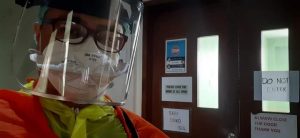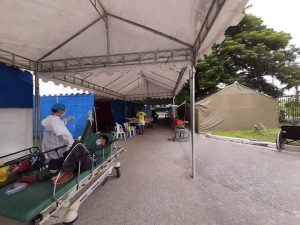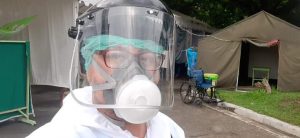By Dr. Genio Dominic B. Alojado, Medical Officer III, Teresita Lopez Jalandoni Provincial Hospital
Seven months had passed and the COVID-19 pandemic has been making its continued sweep all over the islands of the Philippines and it seems like it hasn’t lost its momentum with new hotspots of clusters after former epicenters of transmission have started to wane out.


As we continue to battle and learn to live with this very deadly virus, have you ever tried to see, hear or know what happens in a day at the “battleground” of frontliners in the hospital? Let me share to you how it is in a day of a health worker facing the cunning COVID-19 in a hospital.
MONDAY. The first day of the work week. My duty lasted for 12 hours.
5:45 a.m. The cellphone’s alarm woke me up. That sleepy pall lingers but time was really ticking fast once I tried to close my eyes again. Oooops, it was already 6:30 a.m.! So out of the bed, and into the bathroom. Shaved the beard and moustache today? Naaah. Just trimmed out excess and sculpted it. Keeping a beard and a moustache makes wonders at work.
6:50 a.m. Scrub suit, check. Extra dri-fit shirt, check. Extra sleeveless shirt, check. Respirator, check. Inside the bag they go. Checked cellphone for new messages, group updates at the chatbox. Why such “extras?” You will discover later. Of course, face mask.
7:00 a.m. Breakfast was being cooked – rice, fish, chicken nuggets – and it was off to the lunchbox. Added to it a fruit and leftovers for snacks.
7:30 a.m. Hitting the road, stepping on gas, tricycles, other cars. Trying to make sure no traffic jams and bottlenecks at the intersections. Nice music from the “Breakfast Club” at the FM radio keeps the rhythm running for work. ID worn for sure at the checkpoints
8:00 a.m. Just in the nick of time after finding a parking slot in an array of motorcycles, I had the security guard pointed a contactless thermometer at my forehead.
“36.7 degrees Celsius, doc.”
Logged in at the book for attendance and then with my bags thru the hallways of the hospital and to the Medicine call room.
8:30 a.m. E.R. duty! Yey (sarcastic). While eating breakfast, the outgoing physician endorsed patients.
“Patient at ER bed 1 is already admitted. Stroke, infarct at left basal ganglia. Stable with left-sided weakness. All ER OPD patients are for discharge after consuming their IV fluids. There are two patients waiting for the RT-PCR swab tests at the isolation tent. Made rounds today and tent 1 still coughing with fever but not dyspneic. At tent 3, patient still has fever and shortness of breath but stable. Tents 2, 4 and 6 are empty.”
Endorsement ended with coffee and reminders of the day to be on alert with increasing COVID-19 suspects coming to the ER.
9:00 a.m. Brushed teeth, gargled mouthwash and washed face. Next, stuffing my PPE mask in the ultraviolet sterilizer and run it to instructions. Then here it came. Donning of the PPE: dri-fit shirt, scrub pants, slip on shoes, the PPE overalls, inner gloves, face mask, goggles. All ballpens, mobile phones stuffed in my clutch bag, then with the face shield, I went to the ER.
9:30 a.m. Charts at the ER reviewed. No new admissions yet as the wards were disinfected after a week of COVID patients. Wrote home instructions and prescriptions and ordered patients to be discharged at once as they are well and keep them from getting the virus somewhere else.
10:00 a.m. It was hot already as I stepped into the triage zone just outside the ER. The nurse presented two new charts of patients with flu-like symptoms, cough and shortness of breath just arriving and they were sent to the isolation tents.
“Both from Barangay Mambulac? That’s their fifth since yesterday.”
Then I removed my face mask and replaced them with the tight-strapped respirator, additional apron was worn over the PPE overalls, double gloves worn and then the face shield to top it all. Took the ballpen and stethoscope and left the clutch bag at the triage then went to the isolation tents. The heat and humidity were kicking in as I approached the first patient. Obviously coughing and felt weak, he was 56 years old with diabetes but had fever six days ago. A day ago he was coughing and this morning he had shortness of breath.
“Obviously a COVID-19 suspect: Flu-like symptoms, progressively developing to cough and shortness of breath coming from a place identified with community transmission. O2 saturation seemed OK with support. Let’s keep it that way and have the patient SARSCoV2 RT-PCR swab test.”

I ordered two more patients to undergo RT-PCR test of their nasopharyngeal swab as they came from the same barangay, all with symptoms of COVID-19 occurring within 2 to 14 days. Trying to keep it quick as to limit exposure to COVID suspects and drenching sweat of a sauna-like feeling in my attire, I told the nurse we are done and will await the results to come out. I proceeded to the doffing tent to remove my PPE as directed. Alcoholized gloved hands, removed outer apron. Alcoholized gloves again, removed outer PPE overalls. Alcoholized gloves, removed outer gloves. Alcoholized gloves, removed head cap. Alcoholized gloves and removed respirator then disinfected. Alcoholized gloves, then removed face shield. Put on new surgical mask. As precautionary measure we do not remove inner PPE until the doffing area at the triage or at the ER. Everything is just then wet with sweat.

12:30 p.m. Dri-fit clothes were all wet with sweat. I removed my PPE and my drenched shirt at our intermediate area outside the call-room, then hang it against the aircon exhaust. I changed into a fresh undershirt and started eating lunch. No companions eating at the table as part of our physical distancing protocol on infection between employees.
1:00 p.m. Gathered my exhaust-dried PPE, dri-fit shirt and outer gown and stuffed it in the UV box for UV sterilization. Then I took a quick nap.
1:30 p.m. Triage nurse called at the door because they had another COVID suspect at the tent. So up again in a new dri-fit shirt, PPE and respirator, and went to the triage and checked out the cart. The tent was very humid and hot and while sweating, I saw two more COVID suspects at the tent. Both were coughing after flu-like symptoms for a week. Careful examination with less contact. Swabs were ordered.
2:30 p.m. An ambulance was racing at the emergency ramp, then out came an unresponsive male patient, claimed to be coughing and had shortness of breath for the past three days. Still sweating inside my PPE, they rushed the patient in and the grieving companions.
“BP? None. Heart rate? Zero. No heart tones.”
The face was pale and the lips were already bluish. I ordered for a long lead II of the ECG.
“Flatline.” Then facing the family, I told them, “The patient is dead upon arrival. He had flu and fever in the last two weeks?”
The family denied and said he just had sudden cough and shortness of breath two days earlier.
They told me he was on a maintenance and showed me the medication lists. He was 72 years old and had antiarrhythmics and diabetic meds. I assumed he had a heart attack. So I ordered for post-mortem care.
As I was filling out the OPD and death certificates, the sister of the patient told me that the patient was having a flu a week before after having a regular consultation with a private physician. Then I learned that the physician he had consulted with was a confirmed COVID-19 patient. So I immediately ordered that the resuscitation unit be isolated with the companions, then called that the patient be labeled “COVID suspect” and ordered a post-mortem swab. I reprimanded them for not telling us that he had fever and flu in the last week. With that I ordered for contact tracing and ordered the nurse and endorsed it to the local epidemiologic unit.
6:30 p.m. Time passed in a rush and I was all wet with sweat and fear engulfed me because of almost a breach with that COVID suspect. The triage and ER were reorganized again to cater other incoming patients. I was on to doff my PPE when another ambulance arrived. It was another COVID-19 suspect, complaining of exhausting body pain and persistent cough. Exhausting as it was and so uncomfortable, I made history taking and limited PE. He was 35 years old and my fifth patient coming from Mambulac, Silay City. The barangay is indeed a cluster zone now.
7:30 p.m. I had finished issuing all the orders and arranged patients in the isolation tents. I discharged three other non-COVID OPD patients and sent them off with home medications. I was soaked and reeking of sweat all over. I went to doff at the doffing tent, removed as directed and alcoholized along the way. Then proceeded to the call-room, changed my sweaty clothes and PPE to dry scrubs. Put the soiled wear in a big plastic bag and washed my face and arms. Freshening up, I endorsed the Covid suspects and patients at the isolation tents to the next on-duty doctor.
8:00 p.m. I logged out of the book and brought my baggage to the car and drove home.
Later at home I was informed that the patient who died was confirmed to have been infected with COVID-19 and three other COVID suspects at the isolation tents.
Everyday is a battle not only limited to the virus but on exhaustion, the heat, the pressure of your co-workers, the family members of patients who are affected. Having a beard and a moustache creates that “rough authority” when I would like to stress out and push my patients and their companions to tell the truth on what their medical history was, that’s why I keep this look for now.

History of their present illness is the cornerstone of every physician’s diagnosis and jumpstarts all plans and management to his or her patients. In this time of a pandemic, everyone of us should do our part to help in the battle against the deadly disease. You tell us what you had and what you feel, and we will try to find solutions to your problems. This service is called cooperation./WDJ

